Minerals
Do you know what the softest and hardest type of mineral is or do you know how rocks form? Well let me tell you this the softest type of mineral is Talc and the hardest type of mineral is the Diamond and there both on the Mohs scale which I'm guessing many of you don't know what that means. If you are one those people I highly recommend scrolling down so enjoy having to know all those forming questions in your head vanish you never know how much questions, you had maybe hundreds and hundreds but let them slowly vanish away where your head doesn't have to feel all cluttered. Minerals are what make up rocks. Minerals are made up of 2 or more elements.
Hardness

How would you know what is the hardest mineral and the softest mineral? Well you can find that in a Moh’s scale many of you might know what that is. First you need to know what a Moh’s scale does, a Moh’s scale measures the hardness of a mineral and also identifies the mineral, a Moh’s scale has a scale that measures from 1-10. For a example Talc is the softest mineral so the number is one and the hardest mineral is the diamond which is number 10 so it would be the hardest. The higher the number is on the scale the harder it is. Some of the minerals you can scratch with your finger nails, with Talc you can scratch with your fingernail and the same with Gypsum.
Streak
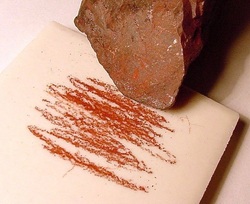
Hmm… What could possibly be a streak? A streak is when a mineral is rubbed across a porcelain tile (which is unglazed) it leaves a streak. Some streaks may not have a streak depending on what colour or what kind of mineral it is. The streak is the colour of powdered form from the mineral. Mineral 7 or greater do not leave a streak because a porcelain tile has a hardness value of 7. A streak test is a way to identify if a mineral. For a example if you do a streak test on gold it comes out as a golden streak and on pyrite the streak leaves a greenish, black or brownish black streak.
Colour
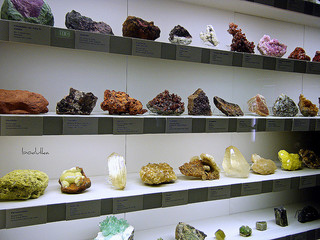
How would you know what is the hardest mineral and the softest mineral? Well you can find that in a Moh’s scale many of you might know what that is. First you need to know what a Moh’s scale does, a Moh’s scale measures the hardness of a mineral and also identifies the mineral, a Moh’s scale has a scale that measures from 1-10. For a example Talc is the softest mineral so the number is one and the hardest mineral is the diamond which is number 10 so it would be the hardest. The higher the number is on the scale the harder it is. Some of the minerals you can scratch with your finger nails, with Talc you can scratch with your fingernail and the same with Gypsum.
Fracture & Cleavage

How does minerals breaking apart have anything to identify mineral? Mineral breaking apart can be a next step of identifying a mineral, because when a mineral breaks along a smooth, flat surface it will be called a “Cleavage” but if the mineral breaks off roughly or has jagged edges it will be called a “Fracture.”
Crystal Structure
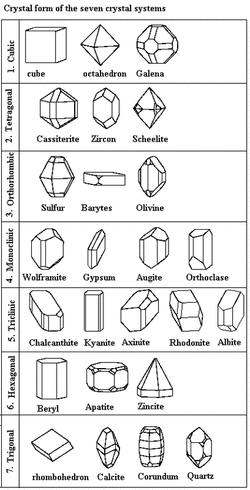
Is crystal structure shiny? Diffinently NOT! Crystal Structure is very important for identifying minerals. Often crystal structure is hard to identify because the crystals are too small to be seen, but sometimes a crystal structures are visible. The minerals in Earth’s crust the mineral develops into beautiful shapes. Their are seven different crystal systems.
Lustre
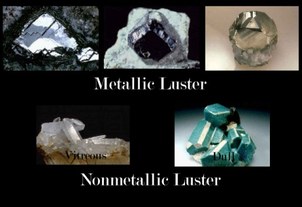
There many kinds of shiny minerals and very dull mineral, but are you not curious? There are some minerals like gold and silver this gives an idea what kind of mineral it is. The shininess on the mineral is called the “Lustre.” If the mineral shines like a polished metal it is called “Metallic Lustre” but if the mineral doesn’t shine like polished metal it is called a “Non-Metallic Lustre.”
Rocks
Ah! I don't know anything about rocks, how they form and what types of rocks there are! What should I do? Hm... I wonder what could possibly help me? Oh, I know I should scroll down to the rocks section. oh look at that! There are types 3 types of rocks Igneous, Sedimentary and Metamorphic, I didn't know that. Well I need more knowledge on how the rocks form so I'm going to read on! Before you read on there are 2 kinds of forms the rocks form as in there are rocks that form inside the earth, which is called "Intrusive", and there are rocks that form outside of the earth, which is called the "Extrusive rock" if you want to learn about intrusive, extrusive or any other kind of keywords that you could find in those types of rocks, such as the cementation and compaction for sedimentary and for metamorphic heat and pressure the example of keywords I have given you is very important to the rock cycles for each rock and rocks are substances that have been made up of different minerals that have been created above and below the earths surface it also depends on if the rock has been cooling for a short or long period of time.
Igneous Rocks
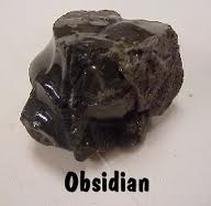
Do you know about 90% of the Earth's upper crust is made up of igneous rocks? I'm guessing you had no idea! What do you think intrusive and extrusive means? It means when a rock is intrusive it has formed beneath the Earth's surface which cools very slowly so when you look at intrusive type of rocks you can see the crystal structure in the rock. But when a rock is extrusive which has formed outside of the Earth's surface and cools very quickly and you rarely see the crystal structure in the rock that is one answers why igneous rocks look similar to other rocks. Igneous rocks don't always stay igneous they can turn metamorphic or sedimentary for a example quartz, obsidian, pumice and basalt won't always stay the same they can change into different kinds of rocks. If you would want to learn more about how the rocks change you should look at the rock cycle section to see how different rock form and change.
Sedimentary Rocks
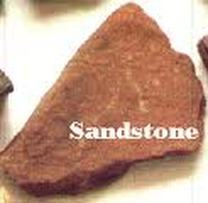
How could sedimentary rocks possibly form? I wonder let me tell you, sedimentary rocks are formed by compaction and cementation and they are formed in water. Sedimentary rocks are made from chemical reactions such as the salt (halite), gypsum and limestone those are some types of rocks that are formed by chemical reactions. When plants are animals have died it gets covered up by new layers of sediment rock. It eventually turns into a stone, which has fossils in it. A example of a rock that is cementation is conglomerate
Metamorphic Rocks
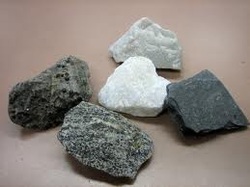
Metamorphic rocks were actually sedimentary and igneous rock. But that all changed… That changed because of the great heat and pressure and that heat can change a lot of things. The heat came from the magma and the pressure came from the rock pile that has layers and layers. The chemical reactions changed a rock to change to another and it keeps on going to more rocks that change (like a cycle keeps on going).
Below there are some examples of rocks that were once sedimentary and igneous rocks:
Marble: Marble is from limestone which is from Sedimentary Rocks. Slate: Slate is from shale which from sedimentary rocks.
Gneiss: Gneiss is from granite which is from igneous rocks.
Quartzite: Quartzite is from sandstone which is from sedimentary rocks.
Below there are some examples of rocks that were once sedimentary and igneous rocks:
Marble: Marble is from limestone which is from Sedimentary Rocks. Slate: Slate is from shale which from sedimentary rocks.
Gneiss: Gneiss is from granite which is from igneous rocks.
Quartzite: Quartzite is from sandstone which is from sedimentary rocks.
Rock Cycle
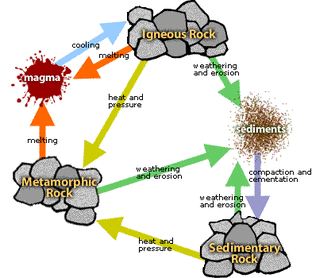
What could possibly be a rock cycle? A rock cycle is a change in rocks, and also is a formation of rocks turning into different types of rocks. For an example Igneous rocks turn into Sedimentary rocks by weathering and erosion which turns the rock into sediments and sediments go through compaction or cementation which turns the rock that was once a Igneous to an Sedimentary rock or if your wondering how a sedimentary rock to become a metamorphic it will have to go through heat and pressure to change. When it becomes a metamorphic rock it can either go through weathering and erosion to become a sedimentary rock again, or it can can melt and can turn to magma again and go through the rock cycle process again.
